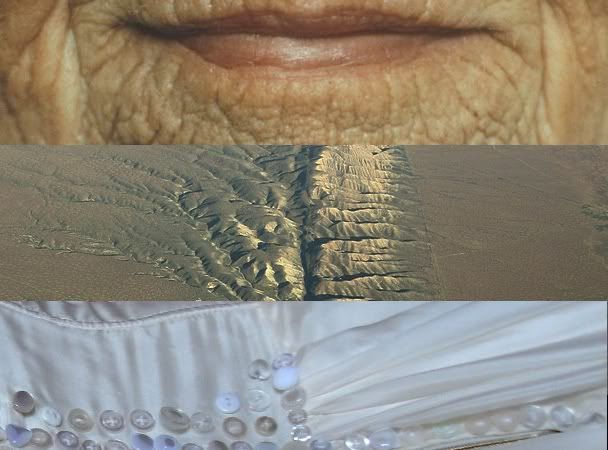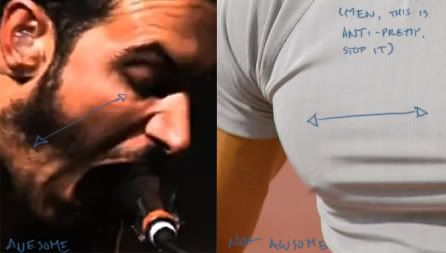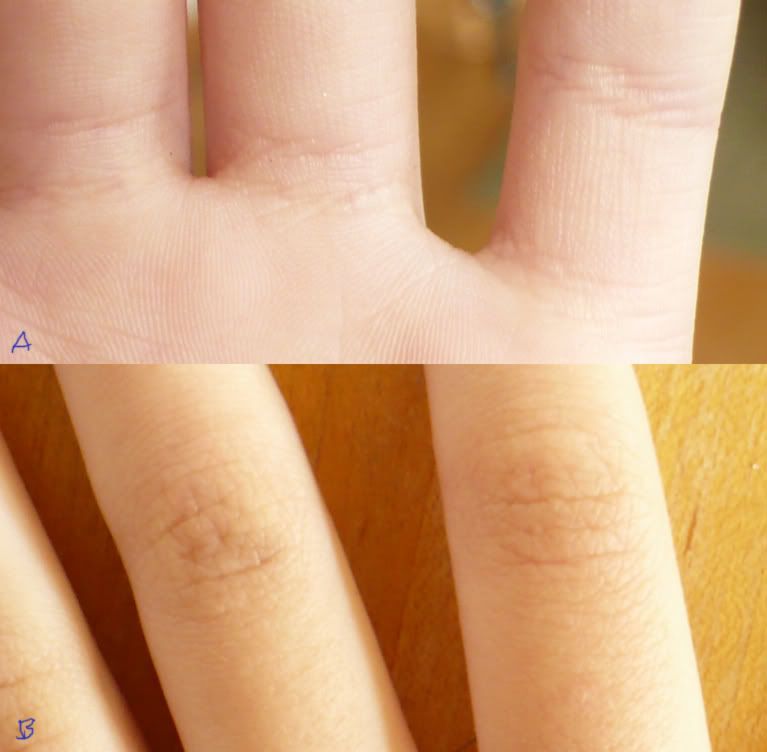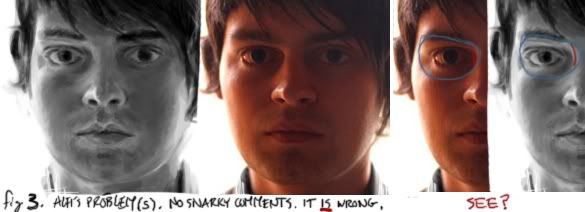I have created a blog for this mess of nearly meaningless theories of facial structure, recognition and artistic reproduction I've got floating around. A good friend suggested it. I think he's brilliant. You know what that means? Endless babbling about stuff no one in their right mind would allow me to talk about in real life! Why? Because if they let me start, endless babbling would happen!

I guess I'll jump right in with the latest and greatest discoveries. Rather, the discovery before last, because I'm not really sure what I just found on the chin (Fig. 1). Sometimes stuff like this is kind of like finding a pretty rock at the entrance to another dimension while heading out with your spunky pals to rescue your little brother from the jaws of evil. You forget all about the pretty rock until you're faced with the terrifying close-up of the jaws of evil and then the entire theater groans because they know it's that part where the annoying kid throws the pretty rock that they forgot at the monster and wins!

Yeah. The chin thing. Whatever it is, it'll be useful later.
The slightly less recent discovery. I am awfully excited about "appley" cheeks. (Example in Fig. 2) It's an absurdly subtle thing and you're going to think I'm crazy. My mother says this is probably "advanced pretty".
The reason these things are so exciting to me is that they explain some of what's going down in cheek land. Cheeks are always tricky to think about. It's like orange jelly in a plastic baggy supported by a bunch of really thin rubber bands.
Our story begins with a friend of mine, who I have to apologize to first. He doesn't like the language I use to describe his face. And I'm probably going to inadvertantly insult him a dozen times before I even finish the second paragraph. Some reassurance, sir. Nothing I'm saying is a judgment on you in any way. Except that you're pretty. And ps, you're face is directly related to Justin Timberlake's. Happy?
Good. Months ago, I confused the hell out of this friend, declaring that his cheeks were "appley" not "poofy". Or maybe the argument was against "marshmallowy"? I don't remember. Because they looked more "solid and intentional". He disagreed, pointing out that if you poked his cheek, it was indeed quite fleshy. Still, I insisted that 'appley' was a far better word for them, I just didn't know why.

(Fig. 3) 'Poofy' is a word I use for... the kind of soft look. I don't say 'fat', because that's not as specific. Fat happens on every one. Poofiness has a certain character to it. Calling a face, or piece of face fat is like describing some one by saying they're black. Tell me a cheek is poofy and I immediately have a general picture of it my head. It's sphere-ish and soft, with few (or just very fine) lines and crinkles. 'Poofy' is like a velvet waterballoon.
I use 'Marshmallowy' to describe a rather different form. When I think 'Marshmallow' I think of the sort of short cylinder shape that marshmallows are. So the general shape is more square, but when you get down to the smaller shapes within the form, things are still kind of rounded. And well... poofy on a small scale.
So when I say some one has a Marshmallow face. I mean it's square with rounded edges (As in Fig. 3, Chris' head is like this). And it might have some poof to it. If I say some one has a poofy face, it's
all round.
"Appley" appeared to be something else entirely. I had the vague idea that it had something to do with the front portion of the cheeks, below the eyes. And that they looked... active. Another word without a definition. I only had the one example so I figured it would have to wait.
Weeks passed and I started to think maybe I was just delusional. That appley cheeks were only a myth that I dreamed up in an attempt to make sense of things, and then stubbornly clung to, just to be contrary. I looked for signs of appley cheeks on other people and came up empty handed. Lots of poofy cheeks. Poofy cheeks with high cheekbones might be called appley in some one else's language, but it doesn't look right to me.
On a seemingly unrelated note, I figured out why my friend reminded me of some one else sometime mid-may. (Fig. 4) I love people who remind me of other people. It almost always leads to breakthroughs. I have to work harder to find what makes both of them look different. And then the real candy is when we figure out what's similar. Because that shows what I'm looking at to recognize them.

Yeah. It's a little squiggle-bob. They look similar because of a squiggle-bob. It took me months to figure that out. I've been finding these sort of lines a lot lately. They're a good shortcut to remember a facial character. Though I don't really know what they are.
It's the pretty rock of this story. So forget about it for a paragraph or two while we find some jaws of evil to chuck it at.

Early September, I finally found another example of Appliness. I only had a moment to throw out a super quick scribble (Fig. 5) but it was enough to convince myself I wasn't batshit insane. Insane, maybe. Batshit, no.
It may not show up that well in my quick doodle, but we've also got a really similar line to the one I had not-so-recently found in both my friend, and Tom's faces. The trick is, Tom's cheeks are decidedly not appley.
Here's where sciencey happy stuff happens. So I figure, the cheekline is apparently connected to this appley cheek thing in some way. Two out of three people I've seen with that line have apple cheeks, and the third has a similarly shaped smile. Um... the smile is important because smiles are all about cheeks. So if we've got a similar shape to the cheeks when Tom smiles, and a similar line, there's got to be a similar underlying mechanism, with one or two small differences that make one "appley" on one just um... not appley. I swear this all made perfect sense in my head.

So. I summoned up my inner stalker and went on facebook. Actually, that's not the stalker-ish part. I also opened up my reference folder of 165 references of Tom Smith (Tom pictured Fig. 6). A little backstory, I've been drawing/studying this guy's face for two years. Pretty much every one in my world is described base T.
One page of scribbling, and a tech week's worth of fuzzy logic later... the important difference is that our original subject has a bigger nose. (I know a nice young man who's hating me a little right now.) Wider really, at bridge.
Looking at figure 6 and 7, you can see the two smile lines happening on Tom. The ones running from nostril past the corner of the mouth. There's a certain shape cheeks take when the "zygomatic major" is active. (That's one of two major smiling muscles.) The cheek balls up kinda under the eyes and makes a long crinkle perpendicular to the muscle itself. Like gathering fabric with a single stitch, if you're a person who sews.

The key word here is "active". I had this word in my head when describing "appely" to myself. Along with the sense that having kind of round bits in front was important. I also knew that the smile was important somehow.
So... What would it look like if a cheek had all the clues for a smile already there? Well, it would have more fat in the front, creating a roundy bit and a little dip/crease area by the nostril, similar to the smile line. Cool. Now I'm going to show you an absurdly subtle example picture. The green lines should show the contour. Hopefully. The first two floating heads are Tom with his own, narrow bridged nose. The second two are what might happen if his nasil bone randomly got wider. (And maybe a little taller too. Sorry, I don't mean to muddy the waters, I'm still learning here too.)

Mmmm.... next time I'll make a bigger example picture. (Fig 8) The point is, with a wider nose, the front area of the cheek wouldn't be as flat. The angle of the flesh that comes down off the side of the nose is softer. So the... 'height' of the cheek is a little greater under the eye. Where the smiles happen. And because it's thicker, the shadow near the nose is a little greater. Making that great faux smile line.
I'm still uncertain how this move might effect the outer portion of the cheeks. Something to remember as I keep working.
Cheekbones also play a big role in this. Because um, they're cheekbones. Obviously. I only have superficial evidence of, well, anyone's cheekbone shape. Because I don't make a habit of cutting open people's faces. Or randomly poking people in the face to see where the cheekbone ends.
Pretty much, I think the cheekbones have to be in a sort of mid way Goldilocks zone for Appley cheeks to really show. People with cheekbones that are higher will tend to get really strong triangular shapes down the side of their face, that overshadow the appliness. Morgan Freeman, back up there in Figure 2, is really close to that catagory. Not quite though.
People with cheekbones that are too low won't have the support under the apple (in the more traditional, make-up person sense of the word) of the cheek. And the cheek will collapse in a kind of William DaFoe kind of way.
Finally, there is a degree of facial fat that's required for this to work. It has to live right there near the side of the nose. The thing I'm still curious about is what makes fat want to live there over some place else? Is it the nice weather? I hear there's a nice school for fat kids in the orbital fad pad, why not there? Tis a puzzlement.
Worth noting, the portion of the cheek that gets appley is part of what I call the "third eyebag" or "third tier eyebag". Don't try to google it. I made it up. I think that's a horse of a different color for another pony ride. I've been working on translating this mess of a thought to english for the better part of two days.
Phew. That was harder than I thought it would be.
















 After the first sketch of the general shape of the head, the orbits (fig 1) and dark areas inside are the first thing I mark (fig 2).
After the first sketch of the general shape of the head, the orbits (fig 1) and dark areas inside are the first thing I mark (fig 2). So I was scribbling around the other day and I happened to finish off the shading in the orbit with a little line down the side where the nose was going to be. And I liked it. That's pretty much the sum of the discovery. (fig 3) That if I make this little line to mark the side of the nose I have a lot easier time seeing where the eyes are supposed to go in the grand scheme of things. See, I have this problem, I repeatedly make my eyes too small, too far apart, and crazy crooked. I think keeping better track of the nose, and the relationship of the eye to it, will help.
So I was scribbling around the other day and I happened to finish off the shading in the orbit with a little line down the side where the nose was going to be. And I liked it. That's pretty much the sum of the discovery. (fig 3) That if I make this little line to mark the side of the nose I have a lot easier time seeing where the eyes are supposed to go in the grand scheme of things. See, I have this problem, I repeatedly make my eyes too small, too far apart, and crazy crooked. I think keeping better track of the nose, and the relationship of the eye to it, will help.





 g
g  s)
s) I guess I'll jump right in with the latest and greatest discoveries. Rather, the discovery before last, because I'm not really sure what I just found on the chin (Fig. 1). Sometimes stuff like this is kind of like finding a pretty rock at the entrance to another dimension while heading out with your spunky pals to rescue your little brother from the jaws of evil. You forget all about the pretty rock until you're faced with the terrifying close-up of the jaws of evil and then the entire theater groans because they know it's that part where the annoying kid throws the pretty rock that they forgot at the monster and wins!
I guess I'll jump right in with the latest and greatest discoveries. Rather, the discovery before last, because I'm not really sure what I just found on the chin (Fig. 1). Sometimes stuff like this is kind of like finding a pretty rock at the entrance to another dimension while heading out with your spunky pals to rescue your little brother from the jaws of evil. You forget all about the pretty rock until you're faced with the terrifying close-up of the jaws of evil and then the entire theater groans because they know it's that part where the annoying kid throws the pretty rock that they forgot at the monster and wins! Yeah. The chin thing. Whatever it is, it'll be useful later.
Yeah. The chin thing. Whatever it is, it'll be useful later. (Fig. 3) 'Poofy' is a word I use for... the kind of soft look. I don't say 'fat', because that's not as specific. Fat happens on every one. Poofiness has a certain character to it. Calling a face, or piece of face fat is like describing some one by saying they're black. Tell me a cheek is poofy and I immediately have a general picture of it my head. It's sphere-ish and soft, with few (or just very fine) lines and crinkles. 'Poofy' is like a velvet waterballoon.
(Fig. 3) 'Poofy' is a word I use for... the kind of soft look. I don't say 'fat', because that's not as specific. Fat happens on every one. Poofiness has a certain character to it. Calling a face, or piece of face fat is like describing some one by saying they're black. Tell me a cheek is poofy and I immediately have a general picture of it my head. It's sphere-ish and soft, with few (or just very fine) lines and crinkles. 'Poofy' is like a velvet waterballoon. Yeah. It's a little squiggle-bob. They look similar because of a squiggle-bob. It took me months to figure that out. I've been finding these sort of lines a lot lately. They're a good shortcut to remember a facial character. Though I don't really know what they are.
Yeah. It's a little squiggle-bob. They look similar because of a squiggle-bob. It took me months to figure that out. I've been finding these sort of lines a lot lately. They're a good shortcut to remember a facial character. Though I don't really know what they are. Early September, I finally found another example of Appliness. I only had a moment to throw out a super quick scribble (Fig. 5) but it was enough to convince myself I wasn't batshit insane. Insane, maybe. Batshit, no.
Early September, I finally found another example of Appliness. I only had a moment to throw out a super quick scribble (Fig. 5) but it was enough to convince myself I wasn't batshit insane. Insane, maybe. Batshit, no.

 Mmmm.... next time I'll make a bigger example picture. (Fig 8) The point is, with a wider nose, the front area of the cheek wouldn't be as flat. The angle of the flesh that comes down off the side of the nose is softer. So the... 'height' of the cheek is a little greater under the eye. Where the smiles happen. And because it's thicker, the shadow near the nose is a little greater. Making that great faux smile line.
Mmmm.... next time I'll make a bigger example picture. (Fig 8) The point is, with a wider nose, the front area of the cheek wouldn't be as flat. The angle of the flesh that comes down off the side of the nose is softer. So the... 'height' of the cheek is a little greater under the eye. Where the smiles happen. And because it's thicker, the shadow near the nose is a little greater. Making that great faux smile line.